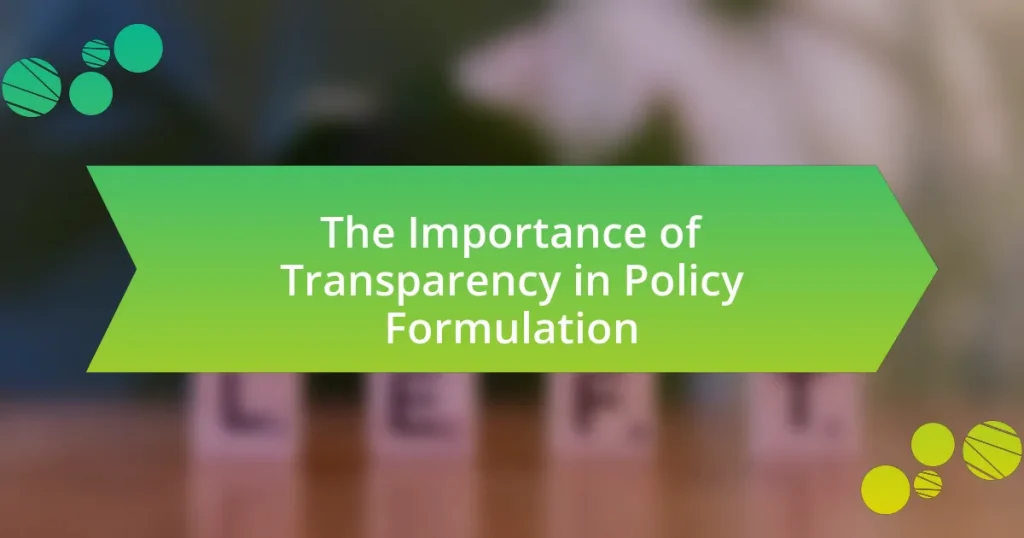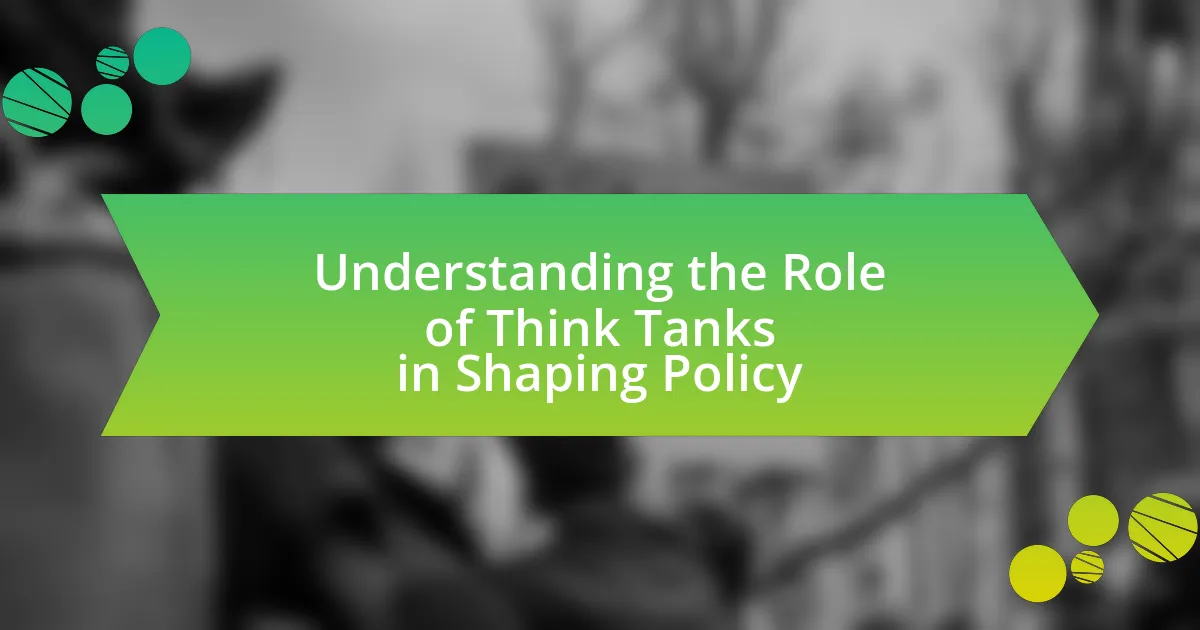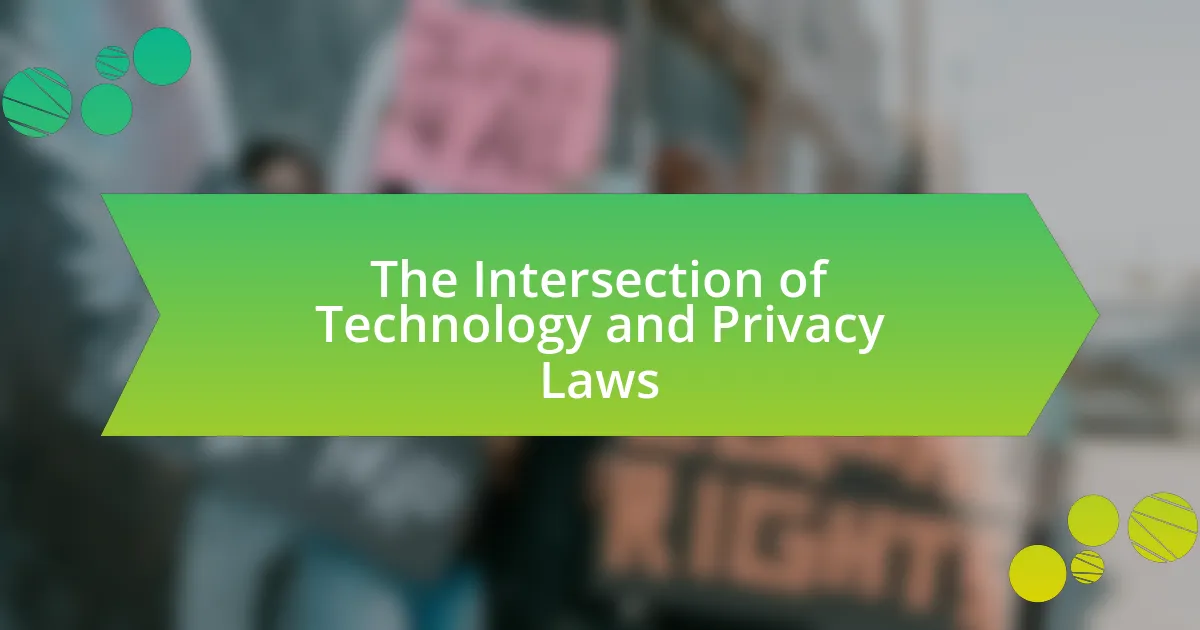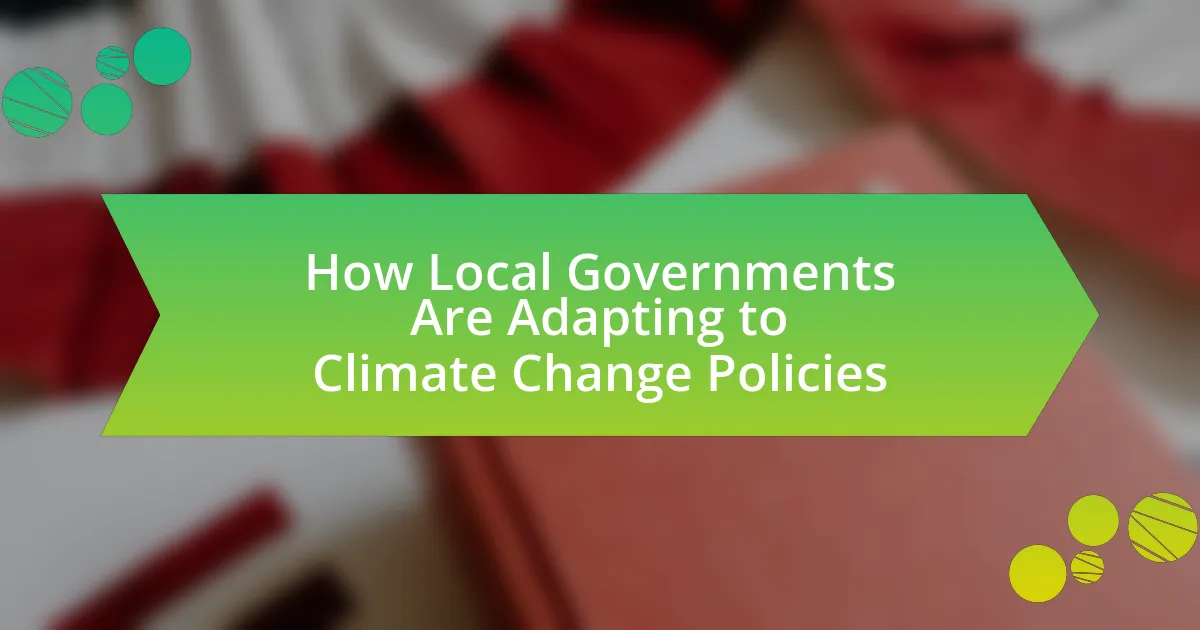The article focuses on the significance of transparency in policy formulation, emphasizing its role in fostering trust, accountability, and public engagement. It outlines key principles such as accessibility, clarity, and stakeholder engagement, which enhance the legitimacy and effectiveness of policies. The discussion includes the impact of transparency on public trust, the importance of stakeholder involvement, and the potential consequences of a lack of transparency, such as increased corruption and public discontent. Additionally, it highlights best practices and successful case studies that demonstrate how transparency can lead to improved governance and better policy outcomes.
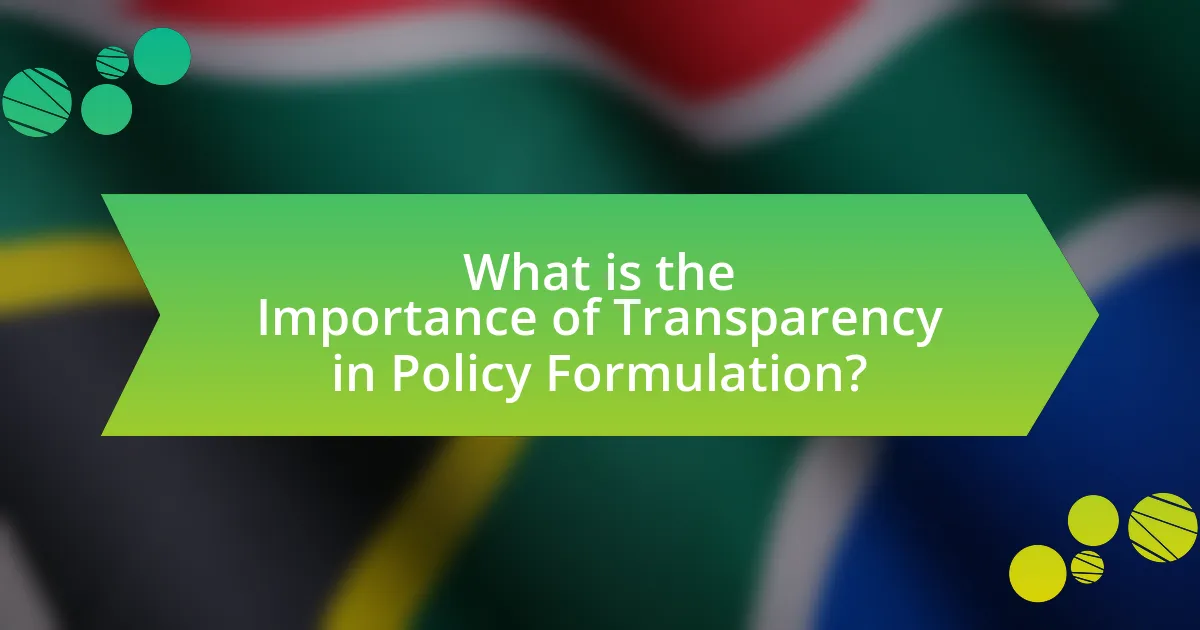
What is the Importance of Transparency in Policy Formulation?
Transparency in policy formulation is crucial as it fosters trust, accountability, and public engagement. When policymakers openly share information and decision-making processes, it allows stakeholders to understand the rationale behind policies, leading to increased legitimacy and support. Research indicates that transparent governance can enhance citizen participation, as seen in studies by the World Bank, which highlight that transparency in public sector management correlates with improved service delivery and reduced corruption. Thus, transparency not only strengthens democratic processes but also ensures that policies are more effective and reflective of public needs.
Why is transparency crucial in the policy-making process?
Transparency is crucial in the policy-making process because it fosters trust and accountability among stakeholders. When policymakers openly share information and decision-making criteria, it enables citizens and interest groups to understand the rationale behind policies, which can lead to increased public support and compliance. Studies show that transparent processes reduce corruption and enhance the legitimacy of government actions, as evidenced by the World Bank’s findings that transparency in governance correlates with improved economic performance and social equity.
What are the key principles of transparency in policy formulation?
The key principles of transparency in policy formulation include accessibility, clarity, accountability, and stakeholder engagement. Accessibility ensures that information regarding policy decisions is readily available to the public, allowing citizens to understand the processes involved. Clarity involves presenting information in a straightforward manner, minimizing jargon to enhance comprehension. Accountability requires policymakers to justify their decisions and actions, fostering trust and responsibility. Stakeholder engagement emphasizes the importance of involving various groups in the policy-making process, ensuring diverse perspectives are considered. These principles are supported by frameworks such as the Open Government Partnership, which advocates for transparency as a means to improve governance and public trust.
How does transparency influence public trust in government policies?
Transparency significantly enhances public trust in government policies by fostering accountability and openness. When governments provide clear information about their decision-making processes, citizens are more likely to feel informed and engaged, which builds confidence in the integrity of those policies. Research conducted by the World Bank indicates that transparency in governance can lead to increased citizen satisfaction and trust, as it reduces perceptions of corruption and promotes a sense of fairness in policy implementation. Furthermore, studies show that transparent communication during policy formulation allows for public input, which not only improves the quality of policies but also strengthens the legitimacy of governmental actions in the eyes of the public.
What role does transparency play in stakeholder engagement?
Transparency is crucial in stakeholder engagement as it fosters trust and encourages open communication. When organizations share information openly, stakeholders feel valued and are more likely to participate actively in the decision-making process. Research indicates that transparency can lead to improved collaboration and better outcomes, as stakeholders are more informed and can provide meaningful input. For instance, a study by the International Association for Public Participation found that transparent processes significantly enhance stakeholder satisfaction and engagement levels.
How can transparency enhance collaboration among stakeholders?
Transparency enhances collaboration among stakeholders by fostering trust and open communication. When stakeholders have access to relevant information, they can make informed decisions, align their goals, and work together more effectively. For instance, a study by the World Bank found that transparency in governance leads to increased stakeholder engagement and cooperation, as it reduces misunderstandings and conflicts. This collaborative environment ultimately results in more effective policy formulation and implementation, as stakeholders feel valued and empowered to contribute their insights and expertise.
What methods can be used to ensure transparency with stakeholders?
To ensure transparency with stakeholders, organizations can implement regular communication, open data initiatives, and stakeholder engagement processes. Regular communication involves providing updates and information through newsletters, meetings, and reports, which keeps stakeholders informed about developments and decisions. Open data initiatives allow stakeholders to access relevant data and documents, fostering trust and accountability. Stakeholder engagement processes, such as surveys and public consultations, enable stakeholders to voice their opinions and contribute to decision-making, ensuring their perspectives are considered. These methods collectively enhance transparency and build stronger relationships with stakeholders.
What are the potential consequences of a lack of transparency?
A lack of transparency can lead to significant consequences, including diminished public trust, increased corruption, and ineffective policy implementation. When transparency is absent, citizens may become skeptical of government actions, resulting in a disengaged electorate and reduced civic participation. Research indicates that transparency fosters accountability; without it, there is a higher likelihood of corrupt practices, as officials may exploit the lack of oversight. Furthermore, policies developed without transparent processes often fail to address the needs of the community, leading to ineffective solutions and wasted resources. For instance, a study by the World Bank found that countries with higher levels of transparency experience better governance outcomes, highlighting the critical role transparency plays in effective policy formulation.
How can opacity in policy formulation lead to public discontent?
Opacity in policy formulation can lead to public discontent by fostering distrust among citizens regarding the intentions and effectiveness of government actions. When policies are developed behind closed doors, the lack of transparency prevents stakeholders from understanding the rationale behind decisions, which can result in perceptions of unfairness or bias. For instance, studies have shown that when citizens feel excluded from the decision-making process, their satisfaction with governance declines, as evidenced by public protests and declining approval ratings in various democratic nations. This disconnect can escalate into widespread discontent, as individuals may believe that their needs and opinions are not being considered, ultimately undermining social cohesion and trust in public institutions.
What risks does a lack of transparency pose to effective governance?
A lack of transparency poses significant risks to effective governance, including corruption, reduced public trust, and ineffective policy implementation. Corruption thrives in opaque environments, as the absence of oversight allows unethical practices to flourish, undermining the integrity of governance systems. For instance, the World Bank has reported that countries with higher levels of transparency experience lower levels of corruption, demonstrating a direct correlation between transparency and ethical governance. Additionally, when citizens perceive a lack of transparency, public trust diminishes, leading to disengagement from civic processes and reduced compliance with laws and regulations. This disengagement can hinder the successful implementation of policies, as public support is crucial for their effectiveness. Therefore, transparency is essential for fostering accountability, building trust, and ensuring that governance mechanisms operate effectively.
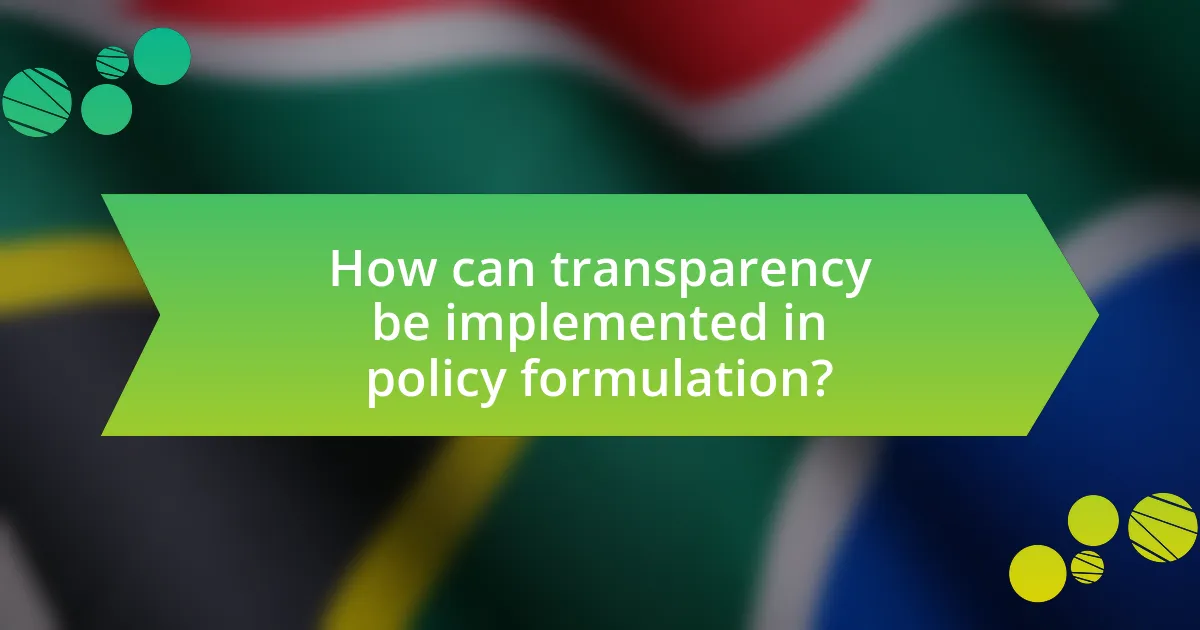
How can transparency be implemented in policy formulation?
Transparency can be implemented in policy formulation through open data initiatives, public consultations, and stakeholder engagement. Open data initiatives allow citizens to access relevant information, fostering accountability and informed public discourse. Public consultations involve soliciting feedback from diverse groups, ensuring that multiple perspectives are considered in the decision-making process. Stakeholder engagement, which includes collaboration with affected communities and organizations, enhances trust and legitimacy in the policy-making process. These methods have been shown to improve policy outcomes by aligning them more closely with public needs and preferences, as evidenced by studies indicating that inclusive policy processes lead to higher satisfaction and compliance rates among citizens.
What strategies can be employed to promote transparency?
To promote transparency, organizations can implement strategies such as open data initiatives, stakeholder engagement, and regular reporting. Open data initiatives involve making relevant data publicly accessible, which fosters accountability and allows for independent analysis. Stakeholder engagement ensures that diverse perspectives are considered in decision-making processes, enhancing trust and collaboration. Regular reporting on progress and outcomes keeps stakeholders informed and reinforces a culture of openness. These strategies are supported by research indicating that transparency leads to improved governance and public trust, as evidenced by studies from the World Bank and various governance indices.
How can technology facilitate transparency in policy-making?
Technology facilitates transparency in policy-making by enabling real-time access to information and fostering public engagement. Digital platforms, such as government websites and social media, allow citizens to access policy documents, data, and decision-making processes easily. For instance, the use of open data initiatives, where governments publish datasets related to budgets and expenditures, empowers citizens to analyze and scrutinize government actions. A study by the World Bank found that countries implementing open data policies saw increased citizen trust and participation in governance, demonstrating that technology can enhance accountability and transparency in policy-making.
What role do public consultations play in enhancing transparency?
Public consultations play a crucial role in enhancing transparency by allowing stakeholders to participate in the decision-making process. This engagement fosters open dialogue between policymakers and the public, ensuring that diverse perspectives are considered. Research indicates that when citizens are involved in consultations, they are more likely to trust governmental processes, as seen in studies conducted by the OECD, which highlight that public participation leads to better-informed policies and increased accountability. By providing a platform for feedback, public consultations not only clarify the rationale behind policy decisions but also empower communities, thereby reinforcing the legitimacy of governmental actions.
What are the challenges to achieving transparency in policy formulation?
Achieving transparency in policy formulation faces several challenges, including bureaucratic complexity, lack of stakeholder engagement, and information asymmetry. Bureaucratic complexity often leads to convoluted processes that obscure decision-making, making it difficult for the public to understand how policies are developed. Additionally, when stakeholders, such as community members or interest groups, are not adequately engaged, their perspectives and needs may be overlooked, resulting in policies that do not reflect the public interest. Information asymmetry occurs when policymakers possess more information than the public, hindering accountability and informed participation. These challenges are supported by studies indicating that effective transparency requires clear communication and active involvement from diverse stakeholders to ensure that policy decisions are understood and accepted by the community.
How can bureaucratic resistance hinder transparency efforts?
Bureaucratic resistance can significantly hinder transparency efforts by creating barriers to information sharing and accountability. When bureaucrats prioritize maintaining the status quo over openness, they may withhold critical data, limit access to decision-making processes, and obstruct public scrutiny. For instance, a study by the World Bank found that bureaucratic inertia often leads to a lack of responsiveness to citizen inquiries, which undermines trust in governmental institutions. This resistance not only stifles transparency but also perpetuates inefficiencies and corruption, as opaque processes allow for misconduct to go unchecked.
What are the implications of political interests on transparency?
Political interests significantly undermine transparency by prioritizing agendas over open governance. When political entities prioritize their interests, they often manipulate information dissemination, leading to selective transparency where only favorable data is shared. For instance, studies have shown that in environments where political interests dominate, such as during election cycles, transparency initiatives are frequently sidelined, resulting in decreased public trust and accountability. This manipulation can manifest in the form of restricted access to information, lack of public engagement in policy-making, and the obfuscation of decision-making processes, ultimately eroding democratic principles and citizen participation.
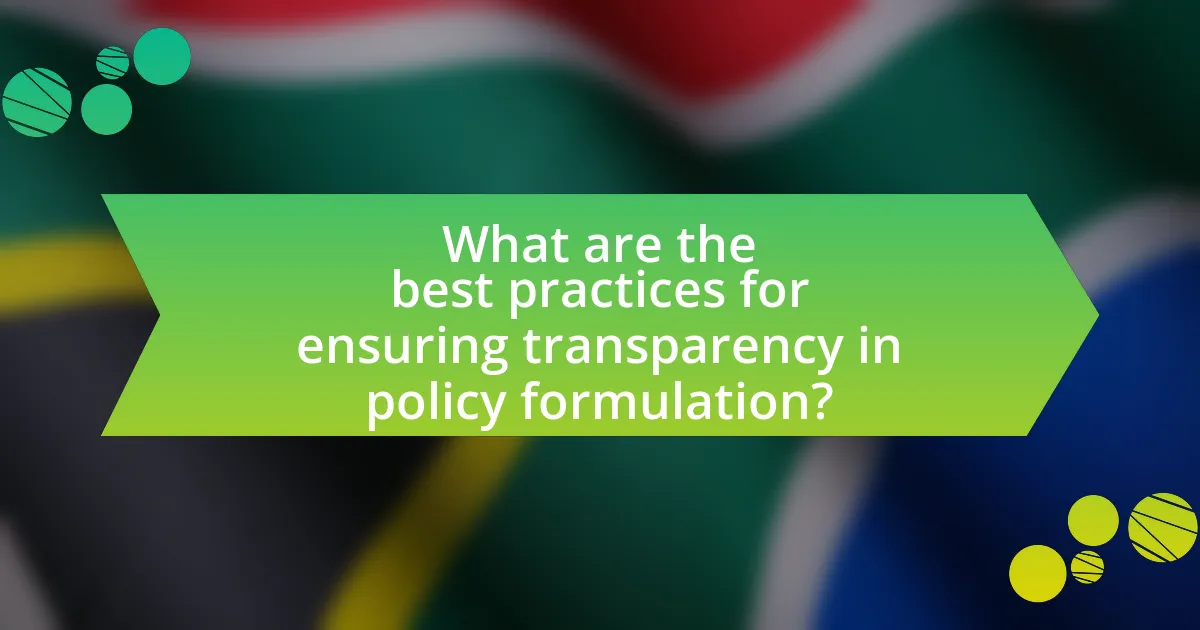
What are the best practices for ensuring transparency in policy formulation?
The best practices for ensuring transparency in policy formulation include engaging stakeholders throughout the process, providing accessible information, and maintaining open communication channels. Engaging stakeholders, such as community members and experts, fosters inclusivity and allows diverse perspectives to shape policy decisions. Providing accessible information ensures that all relevant data, research findings, and policy drafts are available to the public, which enhances understanding and trust. Maintaining open communication channels, such as public forums and feedback mechanisms, allows for ongoing dialogue and accountability. These practices are supported by studies indicating that transparency leads to increased public trust and better policy outcomes, as seen in the World Bank’s report on governance and accountability.
How can policymakers effectively communicate their processes?
Policymakers can effectively communicate their processes by utilizing clear, concise language and engaging multiple communication channels. Clear language ensures that the intended audience understands the policy details without ambiguity, while diverse channels—such as social media, public forums, and official reports—reach a broader audience. Research indicates that transparency in communication fosters public trust; for instance, a study by the Pew Research Center found that 70% of Americans believe that government transparency is essential for accountability. By prioritizing clarity and accessibility, policymakers can enhance public engagement and understanding of their processes.
What tools can be used to disseminate information to the public?
Various tools can be used to disseminate information to the public, including social media platforms, press releases, websites, newsletters, and public forums. Social media platforms like Twitter and Facebook enable real-time communication and broad outreach, allowing organizations to engage directly with the public. Press releases serve as formal announcements that can be distributed to media outlets, ensuring coverage in news articles. Websites provide a centralized location for detailed information, while newsletters can deliver updates directly to subscribers’ inboxes. Public forums, such as town hall meetings, facilitate direct interaction between policymakers and citizens, fostering transparency and dialogue. These tools collectively enhance public awareness and participation in policy formulation.
How can feedback mechanisms improve transparency in policy formulation?
Feedback mechanisms enhance transparency in policy formulation by facilitating open communication between policymakers and stakeholders. These mechanisms allow for the collection of diverse perspectives, ensuring that the voices of affected communities are heard and considered. For instance, public consultations and surveys can reveal public sentiment and inform decision-making processes, leading to more accountable governance. Research indicates that when stakeholders are engaged through feedback channels, policies are more likely to reflect the needs and priorities of the community, thereby increasing trust in governmental institutions.
What lessons can be learned from successful transparent policy initiatives?
Successful transparent policy initiatives demonstrate that openness fosters trust and engagement among stakeholders. For instance, the implementation of the Open Government Partnership has shown that when governments share information and involve citizens in decision-making, public trust increases, leading to higher compliance and participation rates. Additionally, transparent initiatives often result in better policy outcomes, as seen in the case of New Zealand’s public sector reforms, which emphasized accountability and citizen involvement, ultimately improving service delivery. These examples illustrate that transparency not only enhances legitimacy but also encourages collaboration, leading to more effective governance.
Which countries exemplify best practices in transparent policy formulation?
Sweden, New Zealand, and Canada exemplify best practices in transparent policy formulation. Sweden is known for its strong commitment to transparency, supported by the Freedom of the Press Act and the principle of public access to documents, which allows citizens to scrutinize government actions. New Zealand’s government emphasizes open data initiatives and public consultations, fostering citizen engagement in policy development. Canada has implemented the Open Government Partnership, promoting transparency through accessible information and citizen participation in decision-making processes. These countries demonstrate effective frameworks that enhance accountability and public trust in governance.
What case studies highlight the benefits of transparency in policy-making?
Case studies that highlight the benefits of transparency in policy-making include the Open Government Partnership (OGP) initiative and the participatory budgeting process in Porto Alegre, Brazil. The OGP, launched in 2011, has demonstrated that countries that commit to transparency and citizen engagement see improved governance and reduced corruption, as evidenced by the increased public trust and accountability in member countries. In Porto Alegre, the participatory budgeting process, initiated in 1989, allowed citizens to directly influence budget allocations, resulting in more equitable resource distribution and enhanced civic engagement, which led to significant improvements in public services and infrastructure. These examples illustrate how transparency fosters accountability, enhances public trust, and leads to better policy outcomes.
What practical steps can be taken to enhance transparency in policy formulation?
To enhance transparency in policy formulation, governments and organizations should implement open data initiatives that allow public access to relevant information. Open data initiatives have been shown to improve accountability and public trust, as evidenced by the World Bank’s findings that countries with transparent data practices experience better governance outcomes. Additionally, engaging stakeholders through public consultations and feedback mechanisms can ensure diverse perspectives are considered, further promoting transparency. Research by the OECD indicates that inclusive policy-making processes lead to more effective and accepted policies. Lastly, regular reporting on policy progress and outcomes can maintain public awareness and scrutiny, reinforcing the commitment to transparency.
